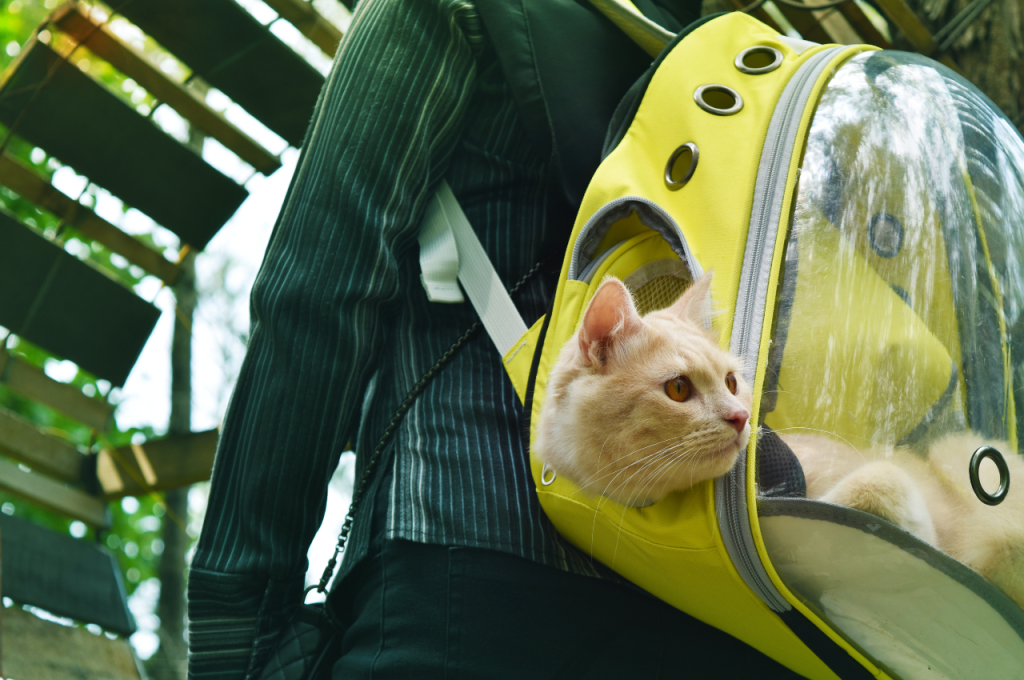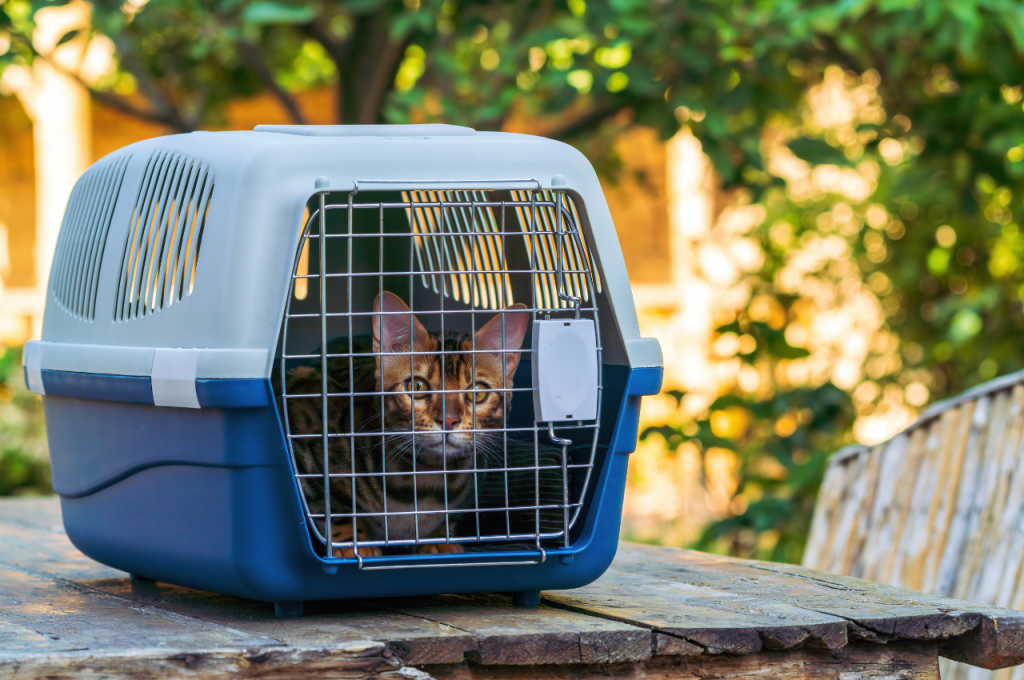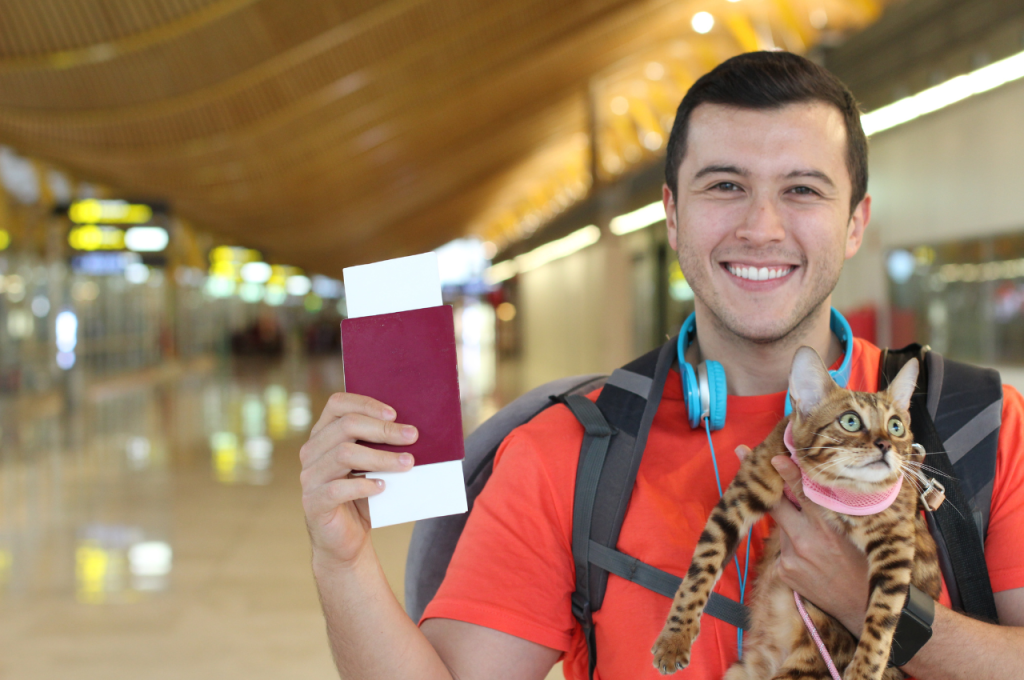To travel with an anxious cat, create a calm environment and use a secure carrier for transport. Now, traveling with a cat who experiences anxiety can be a challenge, but with the right preparations and strategies, you can make the journey more comfortable for both you and your feline companion.
Cats are creatures of habit and thrive on routine, so any disruption to their environment can be stressful. By taking steps to create a soothing atmosphere and using a carrier that provides a sense of security, you can help alleviate your cat’s anxiety during travel. In this blog post, we will explore some tips and techniques to make traveling with an anxious cat a smoother and more enjoyable experience for everyone involved.
Introduction to Feline Travel Anxiety
Traveling with a cat can be a stressful experience, especially if your feline friend is prone to anxiety. Understanding feline travel anxiety is crucial for ensuring a safe and comfortable journey for both you and your cat. This guide will help you navigate the challenges of traveling with an anxious cat, from identifying stress in cats to addressing the reasons behind their discomfort.

Identifying Stress in Cats
Before embarking on a trip with your cat, it’s important to be able to recognize signs of stress in felines. Common indicators of anxiety in cats include excessive meowing, pacing, hiding, loss of appetite, and aggressive behavior. Additionally, physical symptoms such as vomiting, diarrhea, and excessive grooming can also signal distress.
Why Cats Dislike Travel
Cats are creatures of habit and value their territory, so being taken out of their familiar environment can be extremely distressing. The unfamiliar sights, sounds, and smells associated with travel can trigger a cat’s natural instincts for self-preservation, leading to heightened anxiety. Moreover, the motion and vibrations experienced during transportation can further contribute to their discomfort.
Pre-travel Preparation
When it comes to traveling with an anxious cat, proper pre-travel preparation is essential to ensure a smooth and stress-free experience for both you and your feline companion. By taking the time to create a safe travel environment and familiarize your cat with the travel process, you can help alleviate their anxiety and make the journey more comfortable for everyone involved.
Creating a Safe Travel Environment
Before embarking on your journey, it’s crucial to set up a safe and secure travel environment for your cat. This includes ensuring they have a comfortable and well-ventilated carrier that allows them to stand, turn around, and lie down. Additionally, it’s important to place familiar bedding and toys inside the carrier to provide a sense of security and comfort for your cat.
Familiarization Techniques
Introducing your cat to their carrier and the travel process in advance can help reduce their anxiety. Start by leaving the carrier open in your home with treats and familiar items inside to encourage your cat to explore and become comfortable with the space. Gradually increase the amount of time your cat spends inside the carrier, and consider taking short practice trips around the neighborhood to acclimate them to the sensation of traveling.
Choosing The Right Carrier
When it comes to traveling with an anxious cat, choosing the right carrier is crucial for ensuring your pet’s comfort and security. The carrier will be your cat’s safe space during travel, so it’s important to select one that meets their specific needs.
Features of a Comfortable Carrier
A comfortable carrier for your anxious cat should have soft padding to provide a cozy environment. Look for ventilation openings to ensure proper airflow, and secure closures to prevent any accidental escapes. Additionally, consider a carrier with removable mats for easy cleaning and sturdy handles for convenient transport.
Getting Your Cat Accustomed to The Carrier
Getting your cat accustomed to the carrier is essential for a stress-free travel experience. Start by placing the carrier in a familiar environment and leaving the door open to encourage exploration. Gradually, introduce treats and positive reinforcement to create a positive association with the carrier. Short practice sessions inside the carrier will help your cat become more comfortable with it.
Natural Stress Relievers for Cats
Help your anxious cat travel comfortably with natural stress relievers like calming pheromones, soothing music, and cozy bedding. Create a familiar environment in the carrier to ease their nerves during the journey.
Calming Scents and Pheromones
Calming scents and pheromones are natural stress relievers for cats, helping to create a soothing environment. Products like synthetic pheromone diffusers mimic calming signals that cats release naturally, promoting relaxation. Essential oils such as lavender, when used safely and appropriately, can also have a calming effect. Introducing these calming scents can help reduce anxiety and stress in cats, particularly in situations like travel or changes in their environment. Ensure that any product used is specifically designed for cats and consult your veterinarian for advice on safe and effective options.
Comfort Items From Home
To help reduce stress for your cat during travel or in a new environment, bring along comfort items from home. Familiar blankets, bedding, and toys provide a sense of security and can help soothe anxiety. The scent of these items can be calming, as it reminds your cat of their safe space. Additionally, consider using a pheromone diffuser to further alleviate stress. Ensuring that your cat has these comforting items available can make transitions smoother and more manageable for them.
Training Your Cat for Travel
Prepare your anxious cat for travel by gradually introducing them to their carrier, associating it with positive experiences, and offering treats and toys inside. Additionally, take short practice trips to help them acclimate to the experience, ensuring a smoother journey for both of you.
Traveling with an anxious cat can be a daunting task, but it’s not impossible. One of the most important steps you can take to ensure a successful trip is to train your cat for travel. By preparing your furry friend for the journey ahead, you can help reduce their stress and anxiety. In this section, we will explore some positive reinforcement methods and gradual exposure techniques that can help your cat feel more comfortable during travel.
Positive Reinforcement Methods
Positive reinforcement is a technique that involves rewarding your cat for good behavior. This can be especially helpful when training your cat for travel. By providing treats and praise for calm and relaxed behavior, you can help your cat associate travel with positive experiences. Here are some positive reinforcement methods you can try:

- Offer treats and praise for calm behavior during car rides or carrier time.
- Provide toys or a favorite blanket for comfort during travel.
- Practice carrier training at home before traveling.
- Use a calming pheromone spray to help reduce anxiety.
Gradual Exposure to Travel
Gradual exposure is another effective technique for training your cat for travel. This involves slowly introducing your cat to travel over a period of time. By gradually increasing the amount of time your cat spends in the carrier or car, you can help them become more comfortable with travel. Here are some gradual exposure techniques you can try:
- Start by introducing the carrier as a comfortable and safe space in your home.
- Gradually increase the amount of time your cat spends in the carrier.
- Take short car rides with your cat to help them get used to the motion of the car.
- Gradually increase the length of car rides over time.
- Expose your cat to different environments, such as a vet’s office or a friend’s house, to help them feel more comfortable in new places.
By using positive reinforcement methods and gradual exposure techniques, you can help your cat feel more comfortable with travel. Remember to be patient and take things slowly, as every cat is different and will respond differently to training. With time and patience, you can help your furry friend become a seasoned travel companion.
On The Day of Travel
Traveling with an anxious cat can be challenging, but with the right preparation, it can be made more manageable. Start by acclimating your cat to the carrier and planning for breaks during the journey to help reduce their stress. Additionally, consider using calming aids and familiar items to create a comforting environment for your furry friend.
Maintaining Routine
- Start the day with calm interactions and consistent feeding times.
- Keep your cat’s favorite toys and blankets accessible.
Last-minute Tips for a Smooth Departure
- Double-check carrier security and ventilation.
- Bring familiar items for comfort during travel.
- Arrive at the departure point early to reduce stress.
Managing The Journey
Traveling with an anxious cat can be challenging, but with careful planning and preparation, it can be manageable. Creating a comfortable and secure environment for your feline, using calming aids, and maintaining a consistent routine can help alleviate stress and ensure a smoother journey for both you and your pet.
Traveling with an anxious cat can be a daunting task, but with the right preparation, you can make the journey a lot smoother. One of the most important things to consider when traveling with an anxious cat is how to manage the journey itself. Here are some tips on how to keep your feline companion calm and comfortable during transit.
Keeping Calm During Transit
The key to keeping your cat calm during transit is to create a comfortable and secure environment. One way to do this is to use a carrier that is the appropriate size for your cat. The carrier should be large enough for your cat to stand up and turn around in, but not so large that your cat will slide around during the journey. Place a familiar blanket or towel inside the carrier to provide a familiar scent. If your cat is particularly anxious, consider using a pheromone spray or diffuser to help calm them down. These products mimic the scent of a cat’s natural pheromones, which can help reduce anxiety and stress.
Dealing with Motion Sickness
Motion sickness is a common problem for cats during transit. To prevent motion sickness, avoid feeding your cat for several hours before the journey. You can also speak to your vet about medication to help prevent motion sickness. If your cat does become sick during the journey, try to keep them calm and comfortable. Offer them water in small amounts and wipe their face with a damp cloth to help them feel refreshed. If the symptoms persist, speak to your vet about medication to help ease their discomfort.
In conclusion, managing the journey when traveling with an anxious cat requires careful planning and preparation. By following these tips and providing a comfortable and secure environment for your feline companion, you can help ensure a smooth and stress-free journey for both you and your cat.
Post-travel Care
Care for your anxious cat post-travel by creating a safe, quiet space at home. Provide familiar items like blankets or toys to help soothe your feline friend. Allow your cat time to readjust and offer gentle reassurance to ease any travel stress.
Post-Travel Care is just as crucial as preparing for travel when it comes to traveling with an anxious cat. Once you’ve returned home, your cat may need some extra love and attention. Here are some important H3 headings to keep in mind during Post-Travel Care:
Easing Your Cat into a New Environment
Adjusting to a new environment can be stressful for any cat, especially for an anxious one. To ease your cat into a new environment, give them plenty of time to explore their new surroundings on their own terms. Provide them with familiar objects, such as their bed, toys, and food bowls. Keep your cat in a quiet room for a few days to help them adjust to the new environment gradually. Additionally, make sure to give your cat plenty of love and attention to help them feel comfortable and secure.
Monitoring for Post-travel Stress
After traveling, it’s essential to monitor your cat’s behavior for any signs of stress or anxiety. Common symptoms of stress in cats include hiding, excessive grooming, loss of appetite, and lethargy. If you notice any of these symptoms, give your cat some time and space to calm down. Try to create a calming environment by providing plenty of toys, treats, and comfortable bedding. If your cat’s symptoms persist, it’s best to consult with your veterinarian to determine the best course of action.
In conclusion, Post-Travel Care is essential to ensure your anxious cat stays calm and happy. By easing your cat into a new environment and monitoring their behavior for signs of stress, you can help ensure that your feline friend remains healthy and happy after traveling.
Professional Solutions for Severe Anxiety
When it comes to dealing with severe anxiety in cats, professional solutions are vital. Consulting with a veterinarian is the first step in addressing your cat’s anxiety effectively.
Consulting with a Veterinarian
- Schedule a vet visit
- Discuss cat’s anxiety triggers
- Receive personalized advice
Medication and Behavioral Therapy
- Explore medication options
- Consider behavioral therapy
- Implement vet-recommended strategies
Travel Alternatives and Considerations
Traveling with an anxious cat requires special considerations. Help your feline friend stay calm by using a carrier, creating a safe space, and maintaining a consistent routine.

Traveling with an anxious cat can be a challenging experience. However, there are several alternatives and considerations that can make the process less stressful for both you and your furry friend. In this article, we will discuss the different travel options available to cat owners, including when to leave your cat at home, and how to choose a cat sitter or boarding facility.
When to Leave Your Cat At Home
Sometimes, it may be best to leave your cat at home, especially if they are prone to anxiety or motion sickness. This is particularly true if you are only going on a short trip and your cat will be alone for just a few days. Leaving your cat at home under the care of a trusted friend or family member can be a great option. However, if you do decide to leave your cat at home, be sure to leave them with plenty of food, water, and toys to keep them entertained.
Choosing a Cat Sitter or Boarding Facility
If leaving your cat at home is not an option, you can choose to hire a cat sitter or board your cat at a facility. When choosing a cat sitter, look for someone who has experience with anxious cats and can provide a calm and comfortable environment. Alternatively, boarding your cat at a facility can be a good choice, especially if the facility has a separate area for cats. Be sure to research and visit the facility before booking to ensure that it meets your cat’s needs.
Traveling with an anxious cat requires careful planning and consideration. Whether you choose to leave your cat at home or hire a cat sitter or boarding facility, make sure that your cat’s needs are met and that they are in a safe and comfortable environment. By taking the time to prepare, you can ensure that your cat is happy and healthy during your travels.
Conclusion
Traveling with an anxious cat can be a challenging experience, but with proper preparation and care, it is possible to ensure a stress-free journey. By following these tips, such as creating a comfortable and familiar environment, using pheromone sprays, and providing distractions, you can help alleviate your cat’s anxiety and make the trip more enjoyable for both of you.
Remember, patience and understanding are key when traveling with an anxious cat.
